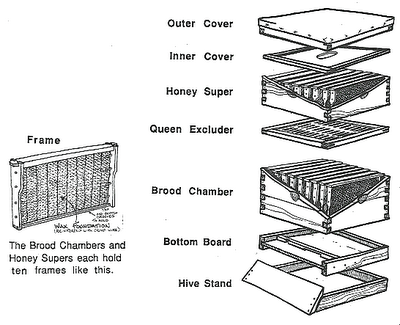Parts of a beehive
Yesterday was my first class, and I think it went well. Among other things, the coordinator explained the parts of the hive, which consist of:
An outer cover, which is, simply put, a lid.
An inner cover, that acts as a spacer between the outer cover and the main part of the hive.
Honey supers, which are boxes that each have 10 "frames" that bees will put nectar, and later honey on.
A queen excluder, which keeps the queen bee in the lower part of the hive.
The brood box(es), which is the part of the hive that the queen lives in, and where she lays her eggs, also known as brood.
The bottom board, that is a base that the other parts rest on
And the hive stand, which serves to keep the hive off of the ground.

I also ordered my 2 hives yesterday, I'll get them next week at class. Once I get them, they will need to be assembled and painted, and returned at the march class. After I give the hives to the coordinator, they will put 4 of my frames from each empty hive into an active beehive. The queen of that existing hive will lay eggs on my frames, and in April, those frames will be put back in my hive. Those frames are going to be the beginning of my new hives.
